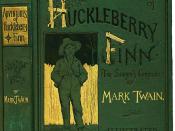It is widely postulated by many that Samuel Longhorne Clemens holds the title of
one of the greatest authors of American History. His literary masterpieces are
revolutionary works, and his style is one of his own. A style to be mirrored by many, yet
mastered by none. The eccentric writer has created a plethora of well read works under a
variety pseudonyms, the most common and well noted, Mark Twain, which he shall be
referred to throughout this analysis of his life, style and influences, and the criticism placed
upon his novel "The Adventures of Huckleberry Finn."
Born November 30, 1835 into the small town of Florida, Missouri, Samuel
Longhorne Clemens led an adventurous life. When a mere four years old, the Clemens
family moved to Hannibal, Missouri, which had a location right along the Mississippi
River. The same river which played host to several of his later novels.
Like many authors
of his day, Clemens had little formal education. His education came from the print shops
and newspaper offices where he worked as a youth. At the age of eighteen, Clemens left
Hannibal for New Orleans, where he persuaded a riverboat pilot to teach him the trade.
By that spring, Clemens had become a licensed riverboat pilot. At the outbreak of the
American Civil War (1861) Clemens chose not to get involved and moved to Carson City,
Nevada. After an unsuccessful stint as a gold and silver miner, he relied on his other
trade, writing. During this period, he adopted his famous pen name "Mark Twain" which
ment "two fathoms" in riverboat lingo. By 1865 Twain had published his first popular
story, "The Celebrated Jumping Frog of Calaveras County." (Lucidcafe and Twentieth
Century Literary Criticism)
While it is well noted that Mark Twain has a...


